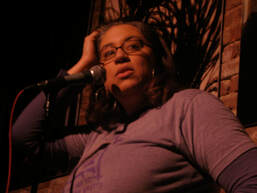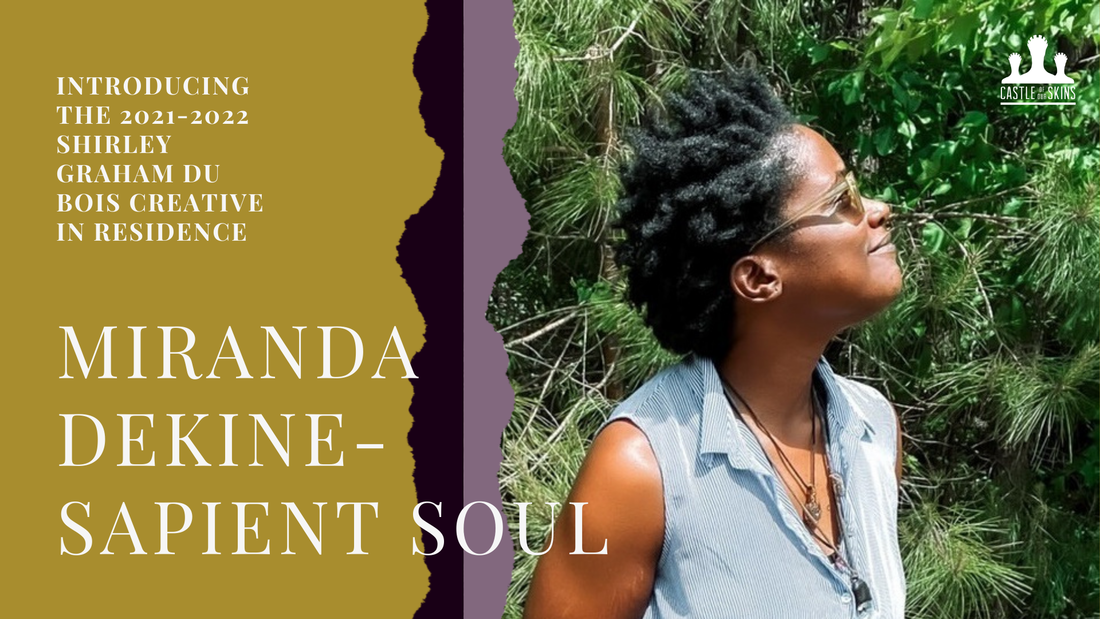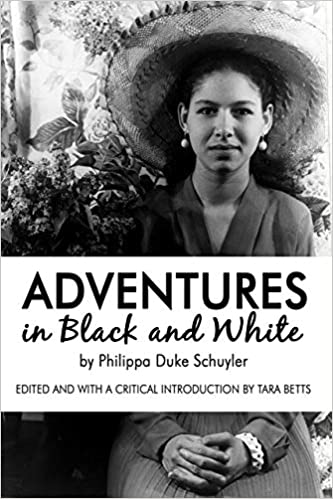|
Hello, BIBA fans! This BIBA Monday blog is a feature of our inaugural Shirley Graham Du Bois Creative-in-Residence, Tanyaradzwa Tawengwa! A musical powerhouse with a wealth of experience in performing, composing, and scholarship, Tanyaradzwa is a vocalist, multi-instrumentalist, composer, and scholar whose work bridges Zimbabwe’s past and present in order to inform a self-crafted future. Her performance style connects the seemingly disparate worlds of Western classical music and Zimbabwean classical music in a trans-continental hybridity. She is part of the 2020 National Sawdust New Works Commission cohort, and has been recently profiled in I Care If You Listen and the Boston Globe. Check out her BIBA feature below! BIBA : How would you describe your overall practice?
TT : My practice is a healing practice. My work is about coming back to the self and the journeys we take to rediscover our wholeness. For me, that journey is rooted in Chivanhu healing practices and ancestral guidance. This modality undergirds all aspects of my creative practice, from process to performance. BIBA : As a scholar, what do you focus on and how has this journey developed? TT : The creation of self-liberated zones is the focus of my scholarship, i.e. Chimurenga chePfungwa. This mandate takes on many forms, namely, the centering of African epistemologies, modalities, forms and voices in my work. This journey has evolved over time, and is continuing to evolve. At this moment, my focus is Love, and how the existential journey to find yourself is actually a journey to Love and accept yourself. BIBA : What is your relationship with your voice and how does that relate to your culture? TT : I come from a voice practice that celebrates each individual’s inherent creativity. On my mother’s side of the family, my great-grandfather was an evangelist, and my great-grandmother would translate his sermons into 11 languages. My grandmother and her siblings were the choir, singing all the hymns. My father’s side of the family didn’t convert to Christianity. They are rooted in Chivanhu practice and it was during our family ceremonies that I connected to mbira music. Mbira dzaVadzimu is the instrument we use in ceremonies to connect with our ancestors. These ceremonies combine body, voice, spirit and all members of the community. All these influences are embodied in my voice practice. BIBA : Who are some influential people in your life (past, present, or future) and why? TT : I have a robust support system that is always there for me. Love is the greatest influence in my life, and it shows itself in many ways: Through my great ancestors who walk with me: Charwe, Dumakude, Pfute, Mbvonyoza, Sekuru Philip, Gogo Soneni, Gogo Lynah, Sekuru John Melusi, Matemai George, Mabel, Auntie Tino, Sekuru Godwin, Uncle Eddie, Itayi and many more known and unknown... Through my teachers, many teachers, and mentors: Mr. Musindo, Mr. Chikaka, Sr. Loyola. Ron Maltais, Uncle Carlton, Everett McCorvey, Dr. Angelique Clay, Somi and many more... Through my friends, family and lovers: Ademisola, Aria, Carly, Ijeoma, Saru, Munashe, Tadisa, Tawanda, my mother and my father, and many more… Through my enemies who are actually divine mirrors, put here to make me the strongest warrior I can be: They have no names. All these names influence my work, and their Love sustains me and shines Light upon me. This Light helps me to see myself clearly and to channel the creativity that resides within. BIBA : I give you the commission of a lifetime: unlimited time, funds, resources, and whatever else you need. What piece would you compose? TT : I would write my story, because my life is the greatest work of art I will ever encounter.
0 Comments
Welcome to the second BIBA Blog that highlights and reviews operas by Black composers, which are full of such richness and breadth! These posts examine the many ways that composers from the African diaspora have used music and drama to tell urgent and necessary stories of love, history, family, and social justice, as well as operas that celebrate or comment upon various aspects of life, the past, and more, with tones ranging from serious to light. In an art form where racism is both deeply and historically ingrained, blackface and yellowface somehow remain hotly debated, and contemporary artists of color are reclaiming the narrative online, the beauty and power of operas by Black composers are part of a necessary operatic revolution.
ANTHONY DAVIS: LEAR ON THE 2nd FLOOR The Composer: Anthony Davis With a career spanning more than thirty years and encompassing multiple genres, eight operas (thus far), and one Pulitzer Prize, Anthony Davis is a living force in classical music, dubbed the “dean of African-American opera composers” by the New York Times. His career first took off in the early 1980s, when Mr. Davis became known as a virtuoso jazz pianist and bandleader (after turning down a 1971 offer to play for the Grateful Dead). But it was his first opera, X: The Life and Times of Malcolm X, premiered in 1986 at New York City Opera, which introduced audiences to Mr. Davis’ eclectic, sophisticated musical style and his focus on politically and socially relevant subjects. Since X, Mr. Davis has written operas based on historical and current events, including the Patty Hearst kidnapping (Tania, 1992), the landmark 1839 ship uprising of enslaved Africans and their subsequent trial (Amistad, 1997), and the spiritual connection between a contemporary Indigineous family and the historical Chief Standing Bear (Wakonda’s Dream, 2007). His works often center the experiences and perspectives of people of color and tackle political subjects, calling art “a healthy way to deal with issues and events that are deeply troubling and still resonate today.” His most recent opera, The Central Park Five (2019), explores the systemic racism and injustice at the heart of this sensationalized case -- five teenage boys accused, convicted and later exonerated of the 1989 rape and assault of a white female jogger in New York City. The opera was awarded the 2020 Pulitzer Prize for Music. Mr. Davis is a longtime professor of music at the University of California, San Diego, and is married to soprano Cynthia Aaronson-Davis. The Opera: Lear on the 2nd Floor Anthony Davis, composer | Allan Havis, librettist | Premiered in 2013 The Basic Plot A contemporary “riff” on Shakespeare, Lear on the 2nd Floor is the story of Nora, an expert in neurodegenerative diseases who is diagnosed with early-onset Alzheimer’s disease. Nora, like Shakespeare’s Lear, has complicated relationships with each of her three adult daughters: Jenna, who performs in adult films and is estranged from her mother; Tara, a self-righteous and greedy accountant who recently married the family lawyer; and Lyla, a pregnant and idealistic substitute teacher whose marriage has recently ended. Nora’s mind deteriorates quickly, and she begins seeing and interacting with her deceased husband, Mortimer. Her daughters’ fight over control of her estate escalates, ultimately landing all of them in court for a bitter battle over legal guardianship. Tara wins, placing Nora into an institution (the “2nd floor” of the opera’s title) as her mind slips away completely. The UCSD Production: Impressions and Thoughts In contrast to Davis’s frequent use of historical events or figures as opera subjects, Lear on the 2nd Floor focuses tightly on a fictional family in turmoil as a way for the opera to investigate meaningful questions about memory, legacy, and the ties that bind. It is a complex work, filled with Nora’s bleak confusion and deteriorating relationships as well as moments of wit and irony. For me, it was really Davis’s score that brings this to life and makes it real -- the music is a sophisticated, and sometimes challenging, blend of dissonance, percussion, jazz, and occasional moments of lyricism. Let’s dive into a few moments to experience how this works. In Act I, shortly after Nora’s diagnosis, Lyla finds her wandering in a cemetery, without her shoes. Their dialogue is bittersweet; Nora’s confusion is evident and she doesn’t remember her daughter at first, but as Lyla confides her ambivalence about her pregnancy and facing it alone, the two manage to connect emotionally in a surprising, lyrical duet. They sing of motherhood, of age, of time and of pain, sometimes in unison, other times in harmony, as the main melody dances along brightly. Lyla, who is based on Shakespeare’s character of Cordelia in King Lear, is patient and loving with her mother, following the twists and turns of her mind and doing her best to take care of Nora in a difficult situation. This clip begins at 14:55, keep watching until about 19:20 for this scene.
Now, contrast that with this section later in Act I. Nora’s condition has deteriorated even more, her mind embodied onstage by a soprano who makes gibberish, wordless vocalizations and screams while the orchestra plays ominously. It’s dark, frightening, and just for a moment, perhaps, makes the audience actually feel the terror of losing one’s mind. This musical moment transitions to Nora herself, who is wandering the street after a confrontation with Jenna. Her aria, like the storm scene of King Lear, gives us a window into her jumbled thoughts as she mixes the past with the present, remembers her daughters and contemplates death. This clip starts at 44:03, keep watching until 50:10.
These are only two examples, but they help to demonstrate the opera’s breadth and style -- the way it can shift from music that is bittersweet and even catchy, to sections that are dissonant, unfamiliar, and challenging.
Nora’s story is not an easy one, especially for the many of us who have seen loved ones taken by Alzheimer’s or dementia and the incredible toll it can take on families. I couldn’t help but think of my own grandmother as I watched, who slipped away early in my childhood and spent her final decade in a gentle, confused fog. She was childlike; she loved coffee ice cream, always perking up for a bowl even when she could no longer feed herself. Davis’s Nora is more like Lear -- a towering, successful figure, a parent with impossible standards, a person betrayed by her own mind and left alone. But there’s also a gentleness in Davis’s ending for her, as Nora and Mortimer imagine driving down an open highway with the radio blaring, reggae echoing in the orchestra. Perhaps, after all, there’s freedom in letting go. The entire opera is available on YouTube through the University of California Television, which is an incredible opportunity to hear the essential work of Anthony Davis, one of the most influential opera composers of our time, for free online. Check it out below and let us know what you think of the opera too.
Additional readings and references:

Lacey Upton is an educator who specializes in the arts, out-of-school time settings, and community engagement. She began her career in opera at the Metropolitan Opera Guild in NYC and spent five years at Boston Lyric Opera as the Director of Community Engagement. She recently earned her Ed.M. from the Harvard Graduate School of Education and currently works in youth development with middle and high school students.
Photo credit: Esso Studios 8/16/2020 When Poetry inspires Song: Bat Dawid’s “What Shall I Tell My Children Who Are Black”Read Now
by Shannon Sea
I was mesmerized when I first heard Angel Bat Dawid’s “What Shall I Tell My Children Who Are Black.” A friend of mine played it for me, on her iPhone. I didn’t quite grasp the lyrics at first, but I found the melody to be distinctly beautiful and haunting.
Bat Dawid’s mezzo-soprano voice carries the melody. Her airy timbre and the cascading melodic contour creates an atmosphere that is deeply melancholic. And Bat Dawid’s use of contrapuntal techniques accentuates the potency of the words: “… to be captive in this, to be captive in this, to be captive in this dark skin.”
When I returned home that evening, I listened to “What Shall I Tell My Children Who Are Black” again. This time, with headphone monitors. I engaged in what I call mindful listening. I was fully present and listened to all the subtleties within the piece. This is when I fully understood the lyrics. Bat Dawid sings, “What shall I tell my children who are Black, of what it means to be a captive in this dark skin.” I investigated the piece more and discovered that it was inspired by Margaret T. Burroughs’s 1963 namesake poem. I then watched a video of Burroughs recite“What Shall I Tell My Children Who Are Black” and was astonished that I had only learned of that poem now. The poem is riveting, and is a raw glimpse into the emotional challenges many Black parents face. The first stanza reads: What shall I tell my children who are Black Of what it means to be a captive in this dark skin What shall I tell my dear one, fruit of my womb, Of how beautiful they are when everywhere they turn They are faced with abhorrence of everything that is black. Villains are black with black hearts. A black cow gives no milk. A black hen lays no eggs. Bad news comes bordered in black, black is evil And evil is black and devils' food is black… The poem continues with four more voluminous stanzas. I invite you to read the rest of it via the links below. My discovery of Burroughs’s poem through Bat Dawid’s piece made me think about how contemporary music can help us rediscover forgotten Black art. Over the past two years, I’ve been mulling the thought of turning into song Alice Dunbar-Nelson’s 1921 lesbian-themed poem, “You! Inez!” I haven’t yet found the right melody for it, but I haven’t given up. Links: Angel Bat Dawid - “What Shall I Tell My Children Who Are Black”: https://www.youtube.com/watch?v=RhvAD8TFrIM Margaret T. Burroughs - Burroughs reading “What Shall I Tell My Children Who Are Black”: https://youtu.be/fEwU86r-nTo Margaret T. Burroughs - “What Shall I Tell My Children Who Are Black”: https://www.poetryfoundation.org/poems/146263/what-shall-i-tell-my-children-who-are-black-reflections-of-an-african-american-mother Alice Dunbar-Nelson - “You! Inez!”: https://www.poetryfoundation.org/poems/52760/you-inez by Tara Betts In 2017, I started to do a deep dive into writings by a pianist and journalist whose tragic demise led me into a fascination with her life. I was introduced to Philippa Duke Schuyler by Gabrielle David, the publisher at 2Leaf Press who spoke with me about reprinting critical editions of out of print titles by Black women. I was thinking in the mindset of the Schomburg Library of Nineteenth-Century Black Women Writers series edited by Henry Louis Gates, but a bit more contemporary. There are many lost voices that could be more valued from the early twentieth century that have immediate context for the 21st century. Philippa Duke Schuyler, daughter of Josephine Codgell and George Schuyler, is no exception to that context. After discussing it with Gabrielle, we decided to pursue reprinting Philippa Duke Schuyler’s Adventures in Black and White (link to buy book and e-book). It’s been 53 years after her untimely death where she drowned during a helicopter accident in Vietnam on May 7, 1967. Much of what I would like to say about her story is what I wrote in a new introduction for a reprint of this 1960 travelogue/memoir. Since then, The Green Book, a highly fictive account of Don Shirley’s travels won the 2019 Oscar for Best Picture. Shirley experienced some of the same levels of discrimination as Schuyler. I am still amazed at how few people still know that Green Books existed, even though many of them are archived and some are even digitized online. I find myself wondering what Schuyler would have thought if she had lived into her 70s and experienced what it might have been like to have Alicia Keys make a movie about her in America. It could have been a Hidden Figures-like moment for a Black woman composer, and I say that as a resident of Chicago, where Florence B. Price, the first Black woman composer to have a symphonic work performed by a major national symphony orchestra happened in 1933 at the Chicago Symphony Orchestra. Neither of these women have been in films either. I am still positing these observations because Schuyler went on record many times saying that she had performed for leaders all over the world, but no American president had ever asked her to perform for them. Although she struggled with her parents’ perceptions of her racial identity as well as what it meant to be adored as a child prodigy who was now a Black adult, and somehow less interesting, and maybe more dangerous, I wonder how that shifted her focus to going overseas and writing. She had been writing poems and compositions and playing the piano since she was a toddler, but writing books allowed her to speak on her own terms and fashion her own identity. As a result, I think she had difficulty establishing an audience that would have been more receptive to her work later. She never had albums of her work released. If you want to learn more about Schuyler, you can find a few recordings of her compositions on YouTube. There are archives at the New York Public Library and Syracuse University, largely due to her mother’s meticulous documentation. Some of her sheet music is in the impressive Helen Walker-Hill Collection at the University of Colorado, and of course, there is the comprehensive biography Composition in Black and White by Kathryn Talalay. There are a few articles and book chapters, but for me, it was valuable to share Schuyler’s own words about traveling as a performer and exploring the larger world at a time when many women were confined by their circumstances. And I keep thinking that there is a need to tell these stories on bigger screens, in larger venues, and making them a part of the larger fabric of history.  Tara Betts is the author of two full-length poetry collections Break the Habit, which was published in October 2016 with Trio House Press, and her debut collection Arc & Hue on the Willow Books imprint of Aquarius Press. In 2010, Essence Magazine named her as one of their "40 Favorite Poets". Betts was born in Kankakee, IL and is the oldest of three siblings. Her first job was at the Kankakee Public Library. Betts received her B.A. in Communication at Loyola University, Chicago. She received her M.F.A. in Creative Writing from New England College in 2007. Betts worked with several non-profit organizations in Chicago, IL including Gallery 37 and Young Chicago Authors. She received her Ph.D. in English/Creative Writing at Binghamton University in 2014. To purchase Adventures in Black and White with edits and a critical introduction by Tara Betts, please CLICK HERE! This special BIBA Blog post is a simple, yet heart-felt and earnest THANK YOU post. Our EIGHTH season has officially started, and - while the end of season seven was not what we desired or expected - we are excited to present to you, our incredible fans, a season with a mixture of digital content, collaborations, live events in the spring, incredible repertoire spanning decades, and a celebration of excellent music and genius artistry. As the conversation about equity and attempting to correct past injustices in classical music continues, we are proud to continue our work in this arena, a labor that has been thriving for seven years now. We are also humbled that so many of you have stepped up to support our work. We cannot survive without your support, and we also cannot grow without acknowledging our growing community.
Castle of our Skins would also like to extend a special shout-out to organizations and individuals who have held fundraising events to support our work! These include: - The Sheffield Chamber Players - Mike Avitabile - Joshua Hahn - Ensemble Vim - James May - the Tufts University Music Department - Society of Composers Inc. (SCI) - and Jonathan Van Ness! We also want to thank the Black Art Futures Fund and New Music USA for their support, organizations who have matched donations from individuals (such as Merck, MassMutual, and the Kenneth Rainin Foundation Discretionary Grant), and the MANY individuals who have sent in donations this year. We look forward to more organizations and individuals who will hold fundraising events (such as the World Piano Teachers Association - Missouri Chapter, lead by Kyu Butler, and a new concert series in Mexico lead by Armando Ortiz)! |
Details
Writings, musings, photos, links, and videos about Black Artistry of ALL varieties!
Feel free to drop a comment or suggestion for posts! Archives
May 2024
|
Member Login
Black concert series and educational programs in Boston and beyond




 RSS Feed
RSS Feed










